OE1022 Digital Lock-In Amplifiers
-
Now OE1022 DSP Lock-In Amplifier is the newest product of core technology with high performance. Based on the digital demodulation, output filter and high-precision stabilized 24-bit ADC, it is ideal to detect the weak signals, which are overwhelmed by greatly larger noise components. And OE1022 could measure the magnitude and phase of a signal simultaneously. It could be comparable with the international leading technology in some core parameters, like accuracy of measurement, range of operating frequency, SNR, dynamic reserve and so on. Meanwhile, we have integrated other functions like multiple-harmonic measurement and FFT in OE1022, which makes this DSP Lock-In Amplifier could meet the needs of scientific research and industrial purposes.
- description
- parameters
Voltage input Mode Single-ended or Differential
Full-scale Sensitivity 1nV to 1 V in a 1-2-5 sequence
Current input 10 or 10 V/A
Impedance
Voltage 10 MΩ // 25pF, AC or DC
coupled
Current 1kΩ to virtual ground
C.M.R.R >100 dB to 10 KHz, decreasing
by 6 dB/oct
Dynamic reserve >100 dB
Gain accuracy 0.2% typ, 1% max
Noise 10nV/√Hz at 1 kHz
0.13pA/√Hz at 1 kHz
0.013pA/√Hz at 100 Hz
Line filters 50/60 Hz and 100/120 Hz
Gounding BNC shield can be grounded
or floated via 1kΩ to ground
Reference Channel
Input
Frequency range 1 mHz to 100 kHz
Reference input TTL or sine
Input impedance 1 MΩ//25 pF
Phase
Resolution 0.01° increments
Absolute phase error <1°
Relative phase error <0.01°
Orthogonality 90°±0.001°
Phase noise
Internal ref. Synthesized, <0.0001°rms at
1kHz
External ref. 0.005°rms at 1 kHz (100 ms
time constant, 12 dB/oct)
Drift <0.01°/℃ below 10 kHz
<0.1°/℃ above 10 kHz
Harmonic detection 2F, 3F, …nF to 100kHz
(n<32,767)
Acquisition time
Internal Ref. Instantaneous acquisition
External Ref. (2 cycles + 5 ms) or 40 ms,
whichever is larger
Demodulator
Stability
Digital outputs no zero drift on all setting
Display no zero drift on all setting
Analog outputs <5 ppm/℃ for all dynamic
reserve settings
Harmonic rejection -90 dB
Time constants 10µs to 3ks (<200Hz)
10µs to 30s (>200Hz)
(6, 12, 18, 24 dB/oct rolloff)
Synchronous filters Available below 200 Hz and 18,24 dB/oct
Internal Oscillator
Frequency
Range 1 mHz to 100 kHz
Accuracy 25 ppm + 30 µHz
Resolution 1 mHz
Distortion -80 dBc (f<10 kHz),
-70 dBc (f>10 kHz)
Amplitude 0.001 to 5 Vrms
Accuracy 1%
Stability 50 ppm/℃
Outputs Sine, 50 Ω output impedance
Display
Screen 5.6 inch, 640×480 TFT
Screen format Single or dual display
Display quantities Each display shows one trace,traces can be defined as X,Y,R,θ
Display types Large numeric readout, bar graph, polar plot and strip chart
Outputs
CH1 and CH2 Outputs
Function X, Y, R, θ
Amplitude ±10 V
Impedance 100 Ω
Interfaces
RS-232 to USB interfaces. All instrument functions can be controlled and read through USB interfaces.
General
Power requirements
Voltage 220/240V AC
Frequency 50/60 Hz
Power 40 W
Dimensions
Width 473 mm
Depth 490 mm
Height
With feet 160 mm
Without feet 147 mm
Weight 11. 9 KG










